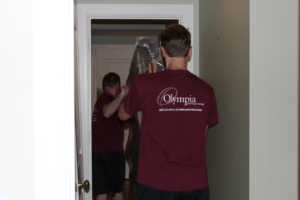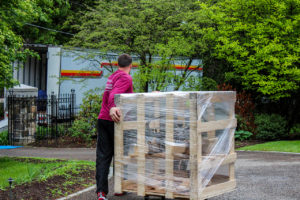The challenge of moving pets has not changed since Olympia posted our Checklist for Moving With Pets. However, there are more factors to consider when moving pets other than dogs and cats. Fido and Streaky can be crated without too much fuss, but Nemo the fish and Treeko the lizard will need more specialized care. Here are Olympia’s tips for moving with small pets.
Moving Lizards and Snakes
You know better than anyone what your reptile needs to thrive. Most pet shops give a comprehensive overview on the environment a reptile requires to live, but if you are unsure you can always call and ask. Heat lamps, humidifiers, and live bugs are are often necessary when it comes to scaly best friends. So, how do you move a reptile?
Check State Restrictions
Not all reptiles are legal in every state. This applies especially to snakes, which often can face city and state laws restricting their presence in certain areas. Make sure that your pet is legally allowed to cross state lines before bringing it to your destination.
Get a Carrier
Ensure that your reptile carrier is the right size for your pet. Clean it, label it, and make it comfortable for a long trip. (Tip: Venomous reptiles need additional protective measures. Ask you veterinarian about the best methods for protecting you, your family, and pet.)
Acclimate
Get your reptile used to its carrier prior to the move. The goal is to reduce stress from an unfamiliar environment. Ideally, the best move would be to keep your reptile in its terrarium for the duration of the journey, but if it is traveling by air, make its temporary housing comfortable.
Doctor’s Visit
Get your reptile checked by its veterinarian within ten days of your move. Current health information is important to have when moving in case any complications arise during the process.


Moving Fish
The last thing fish are meant to do is move across land. Moving for over 24 hours can cause health issues in many fish, while moving for over 48 hours can be fatal. You will need an airtight plan to make sure that Nemo has a comfortable journey.
Clean Water
Replace about 20% of the water in your fishes tank a few days prior to your move. Then, whether you choose to use a bag, a container, or a five gallon bucket, you should use that water to transport your fish. Pull from the top of the tank where the water is cleanest. And, if you do use a bucket, make sure it is completely clean of any chemicals before you place your fish in it.
Last Minute
Don’t remove your fish from it’s tank until absolutely necessary. If possible, it should be the last thing to cross the threshold of your old home.
48-Hour Fast
It’s recommended that you not feed your fish 24-48 hours prior to you’re move. This lessens the need to clean their container/water while traveling.
Container Environment
Regardless of the container you use, make sure that your fish’s ride has 1) enough oxygen and 2) the proper temperature. Fish can die from being shut into their containers or from increased cold or heat. If you are moving a fish that requires warmth, a hot water bottle pressed to the outside of the container can help maintain warmth (this works for lizards, too!). For fish the thrive in room temperature, pay close attention to their water temps while travelling, especially in hot climates.
Tanks
Keep anything that was in the tank in the same tank water. This applies to decorations, filters, and any other objects. Do not clean them, or you will risk losing the good bacteria that helps keep your fish alive in its habitat.
Additionally, you can protect the tank by wrapping it in moving blankets or having it crated. Make sure to cover up the mouth of the tank to protect it from outside debris and contamination. Inform your movers about the care that the tank needs to move if you are not loading the truck yourself.


Moving Rodents (Hamsters, Guinea Pigs, Rats, Mice)
Thankfully, moving rodents is more similar to moving a dog or a cat than a reptile or fish. Read Checklist For Moving With Pets for some good general tips on moving furry friends.
In general, a trip to the vet prior to moving, a clean, airy moving container, plenty of food and water, and proper temperatures will ensure a good move. The main goal is to reduce stress as much as possible, so take as many precautions as you can prior to moving to keep from disturbing your pet.


Moving Birds
Wouldn’t it be nice if we could all fly to where we need to be? Unfortunately, your pet bird cannot fly to meet you at your new home (unless it’s on an airplane). Birds can be very sensitive to change and thus need to be looked after with special care.
Check State Restrictions
Like reptiles, certain birds are restricted from crossing state or city lines. Understand what category of bird your pet is classified under before bringing it to your destination.
Strapped Down
If you are moving your bird in a car, buckle it’s cage into the back seat of your car. Unlike a snake or small rodent, a bird can knock it’s own cage over very easily. This can lead to injury for the animal or damage to the other items in your car. Make sure your bird is secure before you pull out of the driveway.
Acclimatize
Get your bird used to it’s travel cage and the car in small stints at least a week before your move. Purchase a cover to lay over the cage in there is too much direct sunlight or activity outside of the car, but make sure it will not overheat the bird during the journey.
Pack Snacks
Bring a surplus of water, food, and treats for your bird. Depending on what your bird eats, a cooler might be a good investment.
Grab a Harness
An avian harness can allow you to take certain birds out of their cage on long drives. You don’t need to constantly change the bird’s environment, but if you are getting out of the car to sightsee, you won’t have to worry about leaving your pet behind.
Monitor Temperature
Keep an eye on the temperature as you transport your bird. Birds are highly sensitive to changes in temperature, so make sure that you have a plan in place for maintaining a comfortable environment.


Safety First
Keep in mind, NO animal should ever be transported in a moving truck. This is not safe for the animal or the movers. Your pets should travel with you or with a professional pet relocation service.
If moving your pet seems like too big an undertaking, make sure the pet relocation service you choose is right for you. Just like anything else involving your pet, proper care should be the first priory of the organization you pick. Air Animal Pet Movers can transport your pet through air travel while Happy Tails Travel can assist with ground transportation. There are many other options but, regardless, your pet should be transported by caring professionals. Check with the IPATA to ensure that you’ve chosen a registered relocation service.
Your Moving Crew
Talk to your moving crew prior to your move if you are loading specialized items like tanks and terrariums into your moving truck. These items require special packing and loading, so it is important to give the crew as much information as you can. Open communication is key to getting your pet’s home into your new home intact.
If you are looking to move, contact Olympia Moving and Storage today at 800-222-4744 or fill out our free estimate form.











































 The aptly named Old Stone House is the oldest structure on its original foundation in Washington D.C. Constructed in 1766, Old Stone House was once an inn, then a clockmaker’s shop. Strangely, the house became a used car dealership until it was purchased by the National Park Service in the 1950’s.
The aptly named Old Stone House is the oldest structure on its original foundation in Washington D.C. Constructed in 1766, Old Stone House was once an inn, then a clockmaker’s shop. Strangely, the house became a used car dealership until it was purchased by the National Park Service in the 1950’s.











